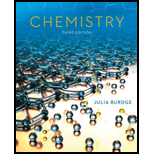
Concept explainers
Interpretation:
The conclusion of the chemist, whether the compound is cocaine or not, is to be explained.
Concept introduction:
Molality (
) is calculated by dividing the moles of the solute by Kg of solvent.
Freezing point depression is a colligative property observed in solutions that results from the introduction of solute molecules to a solvent.
The freezing points of solutions are lower than that of the pure solvent and are directly proportional to the molality of the solute.
where
Want to see the full answer?
Check out a sample textbook solution
Chapter 13 Solutions
Chemistry-Connect Plus Access
- The organic salt [(C4H9)4N][ClO4] consists of the ions (C4H9)4N+ and ClO4. The salt dissolves in chloroform. What mass (in grams) of the salt must have been dissolved if the boiling point of a solution of the salt in 25.0 g chloroform is 63.20 C? The normal boiling point of chloroform is 61.70 C and Kb = 3.63 C kg mol1. Assume that the salt dissociates completely into its ions in solution.arrow_forwardWhat would be the freezing point of a solution formed by adding 1.0 mole of glucose (a molecular compound) to the following amounts of water? a. 250 g (0.25 kg) b. 500 g (0.500 kg) c. 1000 g (1.000 kg) d. 2000 g (2.000 kg)arrow_forwardWhat is the freezing point and normal boiling point of a solution made by adding 39 mL of acetone, C3H6O, to 225 mL of water? The densities of acetone and water are 0.790 g/cm3 and 1.00 g/cm3, respectively.arrow_forward
- The freezing-point depression of a 0.091-m solution of CsCl is 0.320C. The freezing-point depression of a 0.091-m solution of CaCl2 is 0.440C. In which solution does ion association appear to be greater? Explain.arrow_forwardCalcium chloride, CaCl2, has been used to melt ice from roadways. Given that the saturated solution is 32% CaCl2 by mass, estimate the freezing point.arrow_forwardThe vapor pressures of several solutions of water-propanol (CH3CH2CH2OH) were determined at various compositions, with the following data collected at 45C: H2O Vapor pressure(torr) 0 74.0 0.15 77.3 0.37 80.2 0.54 81.6 0.69 80.6 0.83 78.2 1.00 71.9 a. Are solutions of water and propanol ideal? Explain. b. Predict the sign of Hsoln for water-propanol solutions. c. Are the interactive forces between propanol and water molecules weaker than, stronger than, or equal to the interactive forces between the pure substances? Explain. d. Which of the solutions in the data would have the lowest normal boiling point?arrow_forward
 Chemistry: The Molecular ScienceChemistryISBN:9781285199047Author:John W. Moore, Conrad L. StanitskiPublisher:Cengage Learning
Chemistry: The Molecular ScienceChemistryISBN:9781285199047Author:John W. Moore, Conrad L. StanitskiPublisher:Cengage Learning Chemistry: Principles and PracticeChemistryISBN:9780534420123Author:Daniel L. Reger, Scott R. Goode, David W. Ball, Edward MercerPublisher:Cengage Learning
Chemistry: Principles and PracticeChemistryISBN:9780534420123Author:Daniel L. Reger, Scott R. Goode, David W. Ball, Edward MercerPublisher:Cengage Learning
 Chemistry: An Atoms First ApproachChemistryISBN:9781305079243Author:Steven S. Zumdahl, Susan A. ZumdahlPublisher:Cengage Learning
Chemistry: An Atoms First ApproachChemistryISBN:9781305079243Author:Steven S. Zumdahl, Susan A. ZumdahlPublisher:Cengage Learning ChemistryChemistryISBN:9781305957404Author:Steven S. Zumdahl, Susan A. Zumdahl, Donald J. DeCostePublisher:Cengage Learning
ChemistryChemistryISBN:9781305957404Author:Steven S. Zumdahl, Susan A. Zumdahl, Donald J. DeCostePublisher:Cengage Learning General Chemistry - Standalone book (MindTap Cour...ChemistryISBN:9781305580343Author:Steven D. Gammon, Ebbing, Darrell Ebbing, Steven D., Darrell; Gammon, Darrell Ebbing; Steven D. Gammon, Darrell D.; Gammon, Ebbing; Steven D. Gammon; DarrellPublisher:Cengage Learning
General Chemistry - Standalone book (MindTap Cour...ChemistryISBN:9781305580343Author:Steven D. Gammon, Ebbing, Darrell Ebbing, Steven D., Darrell; Gammon, Darrell Ebbing; Steven D. Gammon, Darrell D.; Gammon, Ebbing; Steven D. Gammon; DarrellPublisher:Cengage Learning





